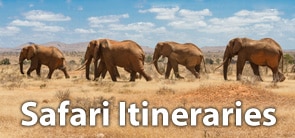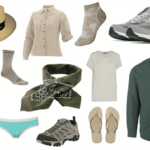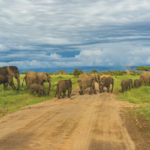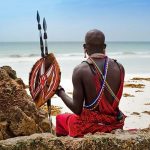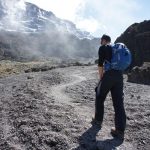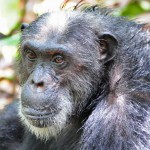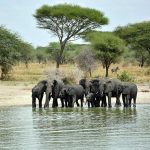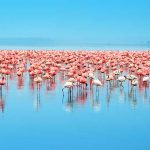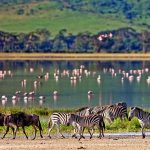Wildebeest Week: Our Story of Witnessing the Rare Calving

Thousands of wildebeests heading north during the ‘Great Migration Season’.
The rains have arrived. The Serengeti stretch is turning lush green. From a distance, skeletal brown bodies in uncountable numbers have been seen walking. Our inquisitiveness spurts. We head in the same direction. What is the movement all about? This elegant march looks more like a fashion parade. We start getting closer and our eyes are startled…. noticing something unexpected.

Alert to the slightest sound, wildebeest gather at dusk
They watch us. But aren’t bothered for very long. We can’t stop watching over them. Herds of antelopes are spread all over the Savannah. Curving hones and a serious face, gray bodies covered in slender skin and so hard to distinguish the males and females. Someone screams. “Hey look at her”. Our head turns in an instance.
The female wildebeest gives birth: Video courtesy of BBC Earth
Stepping away, yet in the middle of the herd, the female wildebeest looks for some space. She sits on the tender grass, completely calm and we turn so restless, ready with our cameras, witnessing one of the rarest happening. She is giving birth, the process so painless and smooth. It is hard to get a glimpse through the grass. Without reckoning, our safari guide moves just a little ahead. The view is perfect.

Nourishment from the mother after birth for an action packed journey.
Our guide, shares, “half a million calves are born at this time of the year.” Born within seconds. We wonder, how most females conceive and give birth almost together. There is certainly a remarkable unison in the wildebeest, which invites travelers from all over the world to the Serengeti. We can’t get our eyes off the young calf and the mother who take some rest after she has nourished her newly born. To our surprise, within few minutes, the wildebeest calf is read to walk and begin a new journey….
The calf gets ready to join the herd. Video Courtesy of BBC Earth
“You are fortunate,” the guide tells us. “It is very rare to witness the birth as much as it is to watch the hunting”. The calves are brave. They begin walking just few minutes after their birth, staying close to their mother. They will feed on grass after 10-12 days and continue to nourish their mother’s milk for almost 5 months. Some feeble and others determined to pick up the pace, two weeks after the birth the calves catch up with the speed of the herd. No one stays back. Around 8,000 wildebeests walk together from South East Serengeti towards Lake Victoria up to May.

Faster than the cheetah? The wildebeest attempts to make an escape
It is during this long journey as they move further together towards the Mara, their survival is at stake. Partly their fate and essentially their courage and speed determine who gets to move on and who is devoured during the ‘The Great Serengeti Migration’. With hungry predators camouflaging with nature, attacks are inevitable. Are only the calves targeted or the speedy wildebeests go astray? Who attacks these migratory herbivores and how many survive? We release some emotional stories in our next episode.
Interested to witness The Great Migration? You may be just lucky to receive the best price on early booking!
Visit : www.kearsleys.com – Your Safari Expert and Award Winning Guide since 1948.
*video courtesy of BBC Earth.

